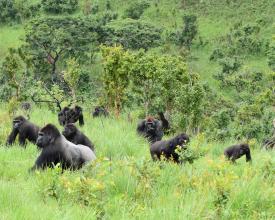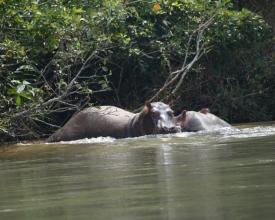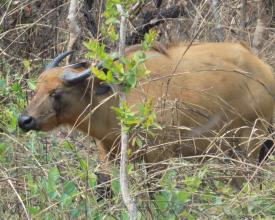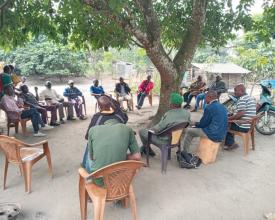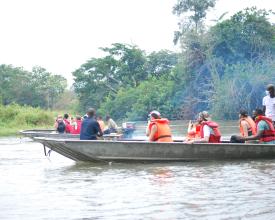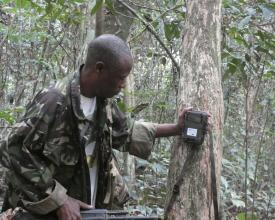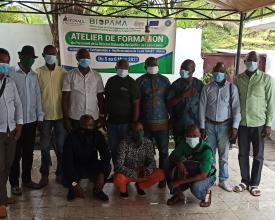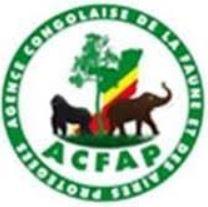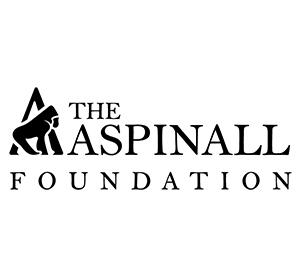
Aplicación de un enfoque polifacético para lograr objetivos de conservación sostenibles a largo plazo en un programa de reintroducción de gorilas de llanura occidentales en peligro crítico de extinción en un área protegida de la República del Congo.
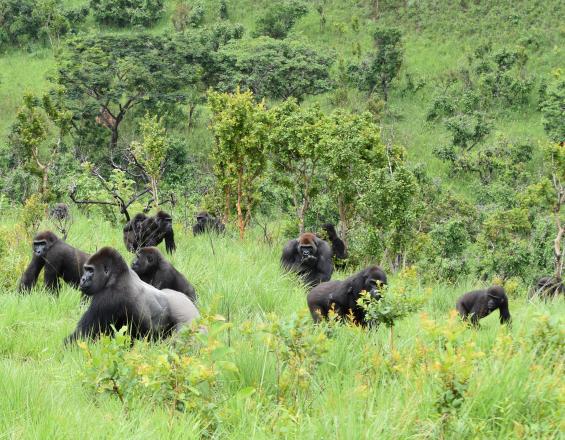
El Proyecto de Protección de Gorilas comenzó en 1987 con el objetivo de reintroducir gorilas occidentales de llanura en peligro crítico en una zona en la que habían sido cazados hasta su extinción. Los gorilas jóvenes, huérfanos a causa del comercio ilegal de carne de caza, reciben cuidados y rehabilitación en el proyecto antes de ser devueltos a su hábitat natural. También los gorilas criados en cautividad son repatriados al Congo donde, tras un periodo de adaptación, también son liberados en la reserva. La protección otorgada a la zona también permite que se beneficie una gama más amplia de flora y fauna, mejorando la biodiversidad y la salud del ecosistema. Sin embargo, las presiones antropogénicas persisten. Para lograr resultados de conservación sostenibles, el proyecto busca una solución holística adoptando un enfoque polifacético de un problema complejo. Esto implica iniciativas de conservación que incluyen el desarrollo de la comunidad local en los pueblos que rodean la reserva, junto con la aplicación de la ley y la protección contra actividades no autorizadas para la fauna y el hábitat de la zona protegida.
Contexto
Défis à relever
La reintroducción en la naturaleza de animales rehabilitados o criados en cautividad requiere un compromiso plurianual y la capacidad de adaptar los procesos y procedimientos cuando sea necesario.
Las guerras civiles y los conflictos entre milicias han asolado la República del Congo durante muchos años, e incluso durante los periodos de relativa estabilidad los proyectos deben gestionarse con cierta sensibilidad al respecto.
Los habitantes de los pueblos que rodean la reserva están atrapados en un estilo de vida de subsistencia debido a la pobreza y la falta de oportunidades en las zonas rurales. Esto, a su vez, ejerce presión sobre la fauna salvaje por prácticas como la caza furtiva, la pesca y la pérdida/degradación del hábitat. También hay una falta histórica de capacitación económica y social, que afecta especialmente a las generaciones más jóvenes y a las mujeres. El ciclo resultante de sobreexplotación de los recursos naturales sólo puede romperse abordando las complejidades del problema con múltiples soluciones que requieren un programa cohesivo y sostenido de conservación y desarrollo comunitario.
Ubicación
Procesar
Resumen del proceso
La interacción de los componentes básicos sigue una progresión natural, desde la preparación y planificación iniciales hasta la aplicación y el futuro. Algunos elementos son comunes a todos ellos, como la colaboración y la buena comunicación. Cada bloque no depende necesariamente de los demás, pero juntos forman un enfoque mucho más cohesionado para abordar las complejas situaciones a las que se enfrentan la mayoría de los proyectos de conservación. Seguir un camino lógico que reúna múltiples aspectos, sobre todo en las áreas que implican algún grado de conflicto entre el ser humano y la vida salvaje, ofrece una oportunidad mucho mejor de lograr soluciones sostenibles.
Bloques de construcción
Colaboración de las autoridades competentes y creación de un equipo
La colaboración eficaz con las autoridades competentes de la República del Congo es un elemento clave del proyecto. Esto no se limita al permiso para llevar a cabo trabajos de conservación en el país, sino que también es importante para las relaciones a largo plazo que se requieren, incluidas las patrullas conjuntas de la reserva y la aplicación de las leyes y reglamentos que son esenciales para la gestión a largo plazo de un área protegida o de conservación. La composición del equipo también es extremadamente importante, y el equipo de Aspinall Congo está formado casi exclusivamente por congoleños.
Factores facilitadores
Un equipo sólido formado por congoleños que entienden los sistemas y procesos del país.
Lección aprendida
Una buena comunicación y el desarrollo de la confianza y el respeto mutuos son importantes para el éxito de las relaciones.
Planificación eficaz
El objetivo original del proyecto era la reintroducción de gorilas de llanura occidentales en peligro crítico de extinción en una zona protegida en estado salvaje. Inicialmente, el proyecto permitiría la liberación de huérfanos rehabilitados nacidos en la naturaleza, con animales criados en cautividad repatriados desde el Reino Unido a medida que avanzara el proyecto. Tener un objetivo claro permitió desarrollar el plan, que incluía, entre otras cosas
- Ubicación y establecimiento del área protegida
- Requisitos legales, incluidas licencias y permisos
- Requisitos de personal, incluida la formación
- Cuidado de los animales, incluido el apoyo veterinario
- Identificación de amenazas y presiones y medidas de mitigación necesarias
- Infraestructura necesaria
- Impacto y compromiso de la comunidad local
- Apoyo de la comunidad local mediante el desarrollo de capacidades y fuentes de ingresos alternativas
- Necesidades de financiación, incluidos los gastos de capital y los costes de funcionamiento
- Estructura de información
- Sostenibilidad
Los proyectos no son estáticos, evolucionan y generan cambios. Además, pueden verse afectados por factores externos. Una vez iniciado el proyecto, ha sido objeto de evaluaciones periódicas. A medida que el proyecto se desarrollaba, se ha ampliado su alcance y se han realizado adaptaciones mediante la supervisión continua de las actividades en curso.
Factores facilitadores
Miembros del equipo altamente motivados y cualificados, con acceso a formación cuando sea necesario. Buena comunicación, tanto en el país como con los miembros del equipo en la sede central del Reino Unido. Claridad en las funciones del equipo y en el proceso de toma de decisiones.
Lección aprendida
Aunque el plan inicial debe estar bien documentado y elaborado, también debe poder adaptarse en caso necesario. Puede haber ocasiones en las que fuerzas externas afecten a un proyecto, por ejemplo durante un periodo de disturbios civiles, en las que se requiera una acción rápida y decisiva.
Participación de la comunidad local
Implicar a las comunidades locales fue un elemento clave de nuestro trabajo en el Congo desde el principio y, en 2010, la Fundación Aspinall pudo crear una estructura más formal con el establecimiento de PROFADELLL (El Proyecto, en Favor del Desarrollo Local en la Periferia de la Reserva Natural de Gorilas Lésio-Louna). Su objetivo era apoyar a las comunidades de la periferia de la Reserva ampliada de Lésio-Louna con un amplio programa comunitario que permitiera a la población local beneficiarse de su entorno y convertirse en custodios del mismo. El programa estuvo en marcha durante un periodo de diez años con resultados positivos y elementos como el producto ecoturístico siguen en marcha.
Factores facilitadores
Las comunidades rurales locales dependen de los recursos naturales que las rodean y tienen un gran interés en realizar una transición hacia estilos de vida más sostenibles. Apoyo de las autoridades locales y nacionales. Compromiso del equipo de generar la confianza necesaria para conseguir el apoyo al programa comunitario.
Lección aprendida
Se consiguen resultados más satisfactorios en todo el proyecto si se mantienen relaciones sólidas con las comunidades locales, lo que exige el compromiso de debatir y escuchar continuamente los puntos planteados en reuniones periódicas. El compromiso de la comunidad local también es crucial para que se mantengan los resultados positivos de conservación.
Acceso a la tecnología
Las cámaras trampa son una herramienta importante para el seguimiento y la recopilación de información, y han sido utilizadas por el equipo durante varios años. Más recientemente hemos podido formar y equipar a los equipos de patrulla en el uso de la Herramienta de Seguimiento e Información Espacial (SMART).
Factores facilitadores
Miembros del equipo de patrulla con ganas de aprender y de mejorar sus competencias, combinados con un programa de formación eficaz para el uso de distintos tipos de tecnología.
Lección aprendida
Tener acceso a las herramientas tecnológicas adecuadas aumenta la eficacia de la recogida de datos y permite un análisis más eficiente en términos de tiempo. Para aprovechar al máximo la tecnología más avanzada, como las patrullas SMART, que requieren una curva de aprendizaje, es necesaria una formación eficaz que garantice que cada patrulla cuente con un mínimo de un miembro del equipo plenamente formado.
Supervisión, evaluación y planificación de proyectos
La supervisión del proyecto desempeña un papel importante en la aplicación de las lecciones aprendidas, y existe un flujo constante de información entre nuestro equipo en el Congo y la oficina del Reino Unido. Además del equipo central, también hay acceso continuo a otros profesionales clave, como nuestro equipo veterinario del Reino Unido, en caso de que se necesite su asesoramiento. El establecimiento de líneas de base eficaces al inicio del proyecto es una herramienta efectiva a la hora de evaluar los progresos. El proyecto no tiene una fecha de finalización definida, y la planificación futura está siempre en revisión. La información y los datos obtenidos a través de la supervisión y la evaluación son elementos clave de la planificación futura.
Factores facilitadores
Buena atención al detalle y disciplina en el mantenimiento de registros. Buena comunicación. Capacidad de innovación y adaptación a situaciones nuevas o cambiantes.
Lección aprendida
Un personal bien formado y motivado garantiza una recogida de datos precisa. El conocimiento de la población local es un recurso valioso. Es importante basarse en los elementos del proyecto que han tenido éxito e igualmente importante analizar y ajustar los que no lo han tenido tanto para que la planificación futura pueda beneficiarse de ambos.
Impactos
El enfoque del proyecto ha llevado a una ampliación natural de su alcance. Su núcleo sigue siendo la reintroducción y protección de la población de gorilas occidentales de llanura, pero su impacto se ha ampliado más allá de una sola especie. La salud del ecosistema en su conjunto forma parte integral del proyecto, y las complejas interrelaciones entre los seres humanos, la vida salvaje y el hábitat son elementos clave. Como ocurre con muchos de los espacios naturales que quedan, los pueblos que rodean la Reserva de Lésio-Louna son algunos de los más pobres del país y dependen en gran medida de los recursos naturales que les rodean. La resiliencia medioambiental y social se consigue capacitando a las comunidades locales para que pasen de un estilo de vida de subsistencia a otro sostenible.
Desde el inicio del proyecto hay una población autosuficiente de gorilas salvajes en la reserva y ha aumentado el número de otras especies, como hipopótamos y búfalos de bosque. Gracias a la formación, la concienciación y la creación de nuevas fuentes de ingresos que fomentan el deseo de proteger la vida salvaje y los hábitats, las comunidades locales han adquirido nuevas habilidades y una mejor comprensión de la importancia de la sostenibilidad. Además de contribuir a una serie de ODS, este desarrollo continuado permitirá en última instancia que la población local se convierta en guardiana de su entorno.
Beneficiarios
Los principales beneficiarios del proyecto son las comunidades locales que viven en los 23 pueblos situados a lo largo de los límites del parque (más de 17.000 habitantes) y, en un contexto más amplio, el gobierno de la República del Congo.
Objetivos de Desarrollo Sostenible
Historia
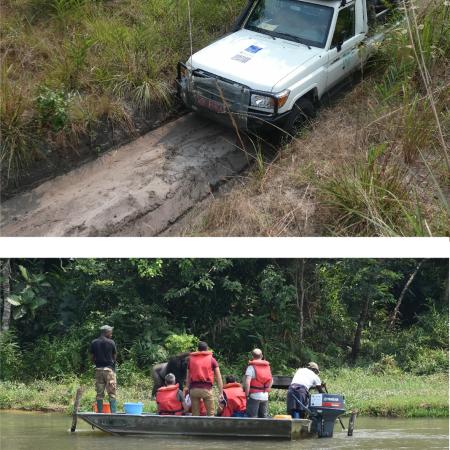
En noviembre de 2020, gracias al apoyo que recibimos de la Unión Europea y la Organización de Estados de África, el Caribe y el Pacífico a través del Programa BIOPAMA, pudimos mejorar significativamente nuestro trabajo en la Reserva de Lésio-Louna. El objetivo era mejorar la protección y la gestión de la reserva mediante una mayor vigilancia contra las actividades ilegales combinada con el desarrollo de un producto ecoturístico ya existente. Se trata de un ejemplo de combinación de múltiples enfoques para lograr un único resultado: proteger el hábitat y la fauna de la Reserva de Lésio-Louna, teniendo en cuenta al mismo tiempo las necesidades de la población local. La compra de un vehículo 4x4 y de cámaras trampa adicionales ha permitido a nuestro equipo organizar patrullas periódicas y supervisar la actividad en una zona de la reserva mucho más amplia de lo que sería posible a pie. En combinación con el uso de la tecnología SMART, ahora conocemos mejor las actividades no autorizadas que tienen lugar en las zonas remotas de la reserva y hemos podido tomar medidas destruyendo campamentos de caza y confiscando artículos como balsas/canoas y rifles de caza. La presencia de las patrullas también está empezando a tener un efecto disuasorio gracias a las actividades de concienciación de nuestro equipo. Junto con este refuerzo de las normas y reglamentos, también hemos mejorado los elementos de un producto ecoturístico mediante la instalación de un nuevo sistema de energía solar y el aumento de la capacidad para ofrecer excursiones fluviales. La creación del producto ecoturístico es una oportunidad para implicar a la población local mediante el empleo directo. A medida que se consolida y aumenta el número de visitantes, también proporciona una fuente de ingresos para los residentes de los 23 pueblos que rodean la reserva, ya que una parte de los ingresos del ecoturismo se paga a las asociaciones de los pueblos en beneficio de la población local.
